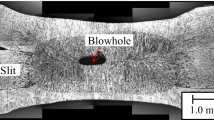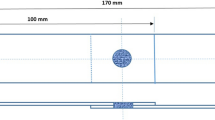Abstract
The resistance spot welding for high-strength low-alloy steel (HSLA DOCOL 500 LA) is examined in this study. Many parameters affect the quality of resistance spot welding such as welding current, welding time and electrode force. It is very necessary to optimize these parameters to increase the quality of welding and to save time and cost. The optimization process was achieved using the Taguchi method for single and double spots. The Taguchi design method, which reduces the number of experiments by arranging the tests into an orthogonal array and choosing the most effective parameters, is one of the best methods for the optimization process. Mechanical, microhardness and microstructure tests were performed. The fatigue test for welded samples with optimum parameters was achieved and measured the crack length using high-accuracy cameras. The impact behavior for welded samples was also carried out using a high-speed servo-hydraulic jack. The fatigue test showed that double spot welding has an endurance limit at a maximum load 1500 N, while for single spot, the endurance limit was 1000 N. Double spot welding design was more resistant to spot welding failure and this led to an increase in the safety of passengers during the crash situations.

































Similar content being viewed by others
References
Gyura L, Gáspár M, Balogh A (2021) Investigation of thermal effects of flame straightening on high-strength steels. In: Jármai K, Voith K (eds) Vehicle and automotive engineering 3. Lecture Note on Mechanical Engineering. Springer, Singapore, pp 526–538. https://doi.org/10.1007/978-981-15-9529-5_46
Sisodia RPS, Gáspár M, Sepsi M, Mertinger V (2021) Comparative evaluation of residual stresses in vacuum electron beam welded high strength steel S960QL and S960M butt joints. Vacuum 184:1–5. https://doi.org/10.1016/j.vacuum.2020.109931
Lukács J, Mobark HFH, Dobosy Á (2021) High cycle fatigue resistance of 700 MPa and 960 MPa strength categories high strength steels and their gas metal arc welded joints. In: Jármai K, Voight K (eds) Vehicle and automotive engineering 3. Lecture Notes in Mechanical Engineering. Springer, Singapore, pp 539–555. https://doi.org/10.1007/978-981-15-9529-5_47
Zhang W, Yang S, Lin Z, Wu T (2020) Weld morphology and mechanical properties in laser spot welding of quenching and partitioning 980 steel. J Manuf Process 56:1136–1145. https://doi.org/10.1016/j.jmapro.2020.05.057
Agashe S, Zhang H (2003) Selection of schedules based on heat balance in resistance spot welding. Weld J 82(7):179–183
Yang YP, Gould J, Peterson W, Orth F, Zelenak P, Al-Fakir W (2013) Development of spot weld failure parameters for full vehicle crash modelling. Sci Technol Weld Join 18:222–231. https://doi.org/10.1016/j.engstruct.2013.09.007
Pouranvari M, Marathi SPH (2011) Failure mode transition in AHSS resistance spot welds Part I. Controlling factors. Mater Sci Eng A 528:8337–8343. https://doi.org/10.1016/j.msea.2011.08.017
Li YB, Li DL, Lin ZQ, David SA, Feng Z, Tang W (2016) Review: magnetically assisted resistance spot welding. Sci Technol Weld Join 21(1):59–74. https://doi.org/10.1179/1362171815Y.0000000059
Moshayedi H, Sattari-Far I (2012) Numerical and experimental study of nugget size growth in resistance spot welding of austenitic stainless steels. J Mater Process Technol 212:347–354. https://doi.org/10.1016/j.jmatprotec.2011.09.004
Pouranvari M (2012) Susceptibility to interfacial failure mode in similar and dissimilar resistance spot welds of DP600 dual phase steel and low carbon steel during cross-tension and tensile-shear loading conditions. Mater Sci Eng A 546:129–138. https://doi.org/10.1016/j.msea.2012.03.040
Shojaee M, Tolton C, Midawi ARH, Butcher C, Ghassemi-Armaki H, Worswick M, Biro E (2022) Influence of loading orientation on mechanical properties of spot welds. Int J Mech Sci. https://doi.org/10.1016/j.ijmecsci.2022.107327
Betiku OT, Shojaee M, Sherepenko O, Midawi ARH, Chertov AM, Ghassemi-Armaki H, Maev RG, Biro E (2022) Optimizing post-weld performance of press-hardened steel resistance spot welds by controlling fusion zone porosity. Weld World 66:1733–1746. https://doi.org/10.1007/s40194-022-01332-2
Wang B, Duan QQ, Yao G (2015) Fatigue fracture behaviour of spotwelded B1500HS steel under tensile shear load. Fatigue Fract Eng Mater Struct 38:914–922. https://doi.org/10.1111/ffe.12289
Viet HH, Quang TN, Anh TT, Thi CHT, Tu AD (2022) Mechanical behavior of the asphalt wearing surface on an orthotropic steel bridge deck under cyclic loading. Case Stud Constr 16:e00836. https://doi.org/10.1016/j.cscm.2021.e00836
Sadiq SE, Bakhyb SH, Jweeg MJ (2020) Effects of spot welding parameters on the shear characteristics of aluminum honeycomb core sandwich panels in aircraft structure. Test Eng Manag 83:7244–7255
Jweeg MJ, Bakhy SH, Sadiq SE (2021) Effects of core height, cell angle and face thickness on vibration behavior of aircraft sandwich structure with honeycomb core: an experimental and numerical investigations. Mater Sci Forum 1039:65–85. https://doi.org/10.4028/www.scientific.net/MSF.1039.65
Fakhri MS, Al-Mukhtar AM, Mahmood IA (2022) Comparative study of the mechanical properties of spot welded joints. Mater Sci Forum 1079:21–28. https://doi.org/10.4028/p-488xsr
Ghanbari HR, Shariati M, Sanati E, Nejad RM (2022) Effects of spot welded parameters on fatigue behavior of ferrite-martensite dual-phase steel and hybrid joints. Eng Fail Anal. https://doi.org/10.1016/j.engfailanal.2022.106079
Shariat M, Nejad RM (2016) Fatigue strength and fatigue fracture mechanism for spot welds in U-shape specimens. Lat Am J Solids Struct 13:2787–2801. https://doi.org/10.1590/1679-78253094
Bonnen J, Agrawal H, Amaya M, Iyengar R (2006) Fatigue of advanced high strength steel spot-welds. SAE Technical Paper.https://doi.org/10.4271/2006-01-0978
Pal TK, Bhowmick K (2012) Resistance spot welding characteristics and high cycle fatigue behavior of DP 780 steel sheet. J Mater Eng Perform 21:280–285. https://doi.org/10.1007/s11665-011-9850-2
Rezayat H, Ghassemi-Armak H, Sriram S, Babu SS (2020) Correlation of local constitutive properties to global mechanical performance of advanced high-strength steel spot welds. Metall Mater Trans A. https://doi.org/10.1007/s11661-020-05714-3
Yurioka N, Suzuki H, Ohshita S, Saito S (1983) Determination of necessary preheating temperature in steel welding. Weld J 62:147–153
ASTM Standard E 8 (2016) Standard test methods for tension testing of metallic materials. ASTM International, West Conshohocken, PA. https://doi.org/10.1520/E0008_E0008M-16A
ASTM Standard E 3-11 (2017) Standard guide for preparation of metallographic specimens. ASTM International, West Conshohocken, PA. https://doi.org/10.1520/E0003-11R17
ASTM Standard E -766 (2014) Standard practice for calibrating the magnification of a scanning electron microscope. ASTM International, West Conshohocken, PA. https://doi.org/10.1520/E0766-14E01
ASTM Standard E -883 (2017) Standard guide for reflected-light photomicrography. ASTM International, West Conshohocken, PA. https://doi.org/10.1520/E0883-11R17
Esme U (2009) Application of Taguchi method for the optimization of resistance spot welding process. Arab J Sci Eng 34:519–528
Ross PJ (2005) Taguchi techniques for quality engineering. Tata McGRAW Hill, New York
Ulrich KT, Eppinger SD (2015) Product design and development. McGraw-Hill Education, New York City
Bilici MK (2012) Application of Taguchi approach to optimize friction stir spot welding parameters of polypropylene. Mater Des 35:113–211. https://doi.org/10.1016/j.matdes.2011.08.033
Specimen dimensions and procedure for shear testing resistance spot and embossed projection welds (1994) International Standard, ISO/DIS 14273
Recommended practices for test methods and evaluation the resistance spot welding behavior of automotive sheet steels (1997) ANSI/AWS/SAE D8?9–97
ASTM Standard E384 – 17 (2017) Standard test method for microindentation hardness of materials. ASTM International, West Conshohocken, PA. https://doi.org/10.1520/E0384-17
ASTM Standard E466 – 15 (2015) Standard practice for conducting force controlled constant amplitude axial fatigue tests of metallic materials. ASTM International, West Conshohocken, PA. https://doi.org/10.1520/E0466-15
Hosseini SV, Kelardeh SM, Heidari M, Parvaz H (2021) Improvement of fatigue life and dynamic strength of an engine mounting bracket using experimental and numerical approaches. Iran J Sci Technol Trans Mech Eng. https://doi.org/10.1007/s40997-021-00461-1
Vardanjani MJ, Araee A, Senkara J, Jakubowski J, GodeK J (2016) Theoretical analysis of shunting effect in resistance spot welding (RSW) of AA2219. J Chin Inst Eng 39:907–918. https://doi.org/10.1080/02533839.2016.1215940
Xing B, Xiao Y, Qin QH (2018) Characteristics of shunting effect in resistance spot welding in mild steel based on electrode displacement. Measurement 115:233–242. https://doi.org/10.1016/j.measurement.2017.10.049
Author information
Authors and Affiliations
Corresponding author
Additional information
Technical Editor: João Marciano Laredo dos Reis.
Publisher's Note
Springer Nature remains neutral with regard to jurisdictional claims in published maps and institutional affiliations.
Rights and permissions
Springer Nature or its licensor (e.g. a society or other partner) holds exclusive rights to this article under a publishing agreement with the author(s) or other rightsholder(s); author self-archiving of the accepted manuscript version of this article is solely governed by the terms of such publishing agreement and applicable law.
About this article
Cite this article
Khaleel, H.H., Mahmood, I.A. & Khoshnaw, F. Fatigue and impact properties of single and double resistance spot welding for high-strength steel used in automotive applications. J Braz. Soc. Mech. Sci. Eng. 45, 155 (2023). https://doi.org/10.1007/s40430-023-04080-6
Received:
Accepted:
Published:
DOI: https://doi.org/10.1007/s40430-023-04080-6




